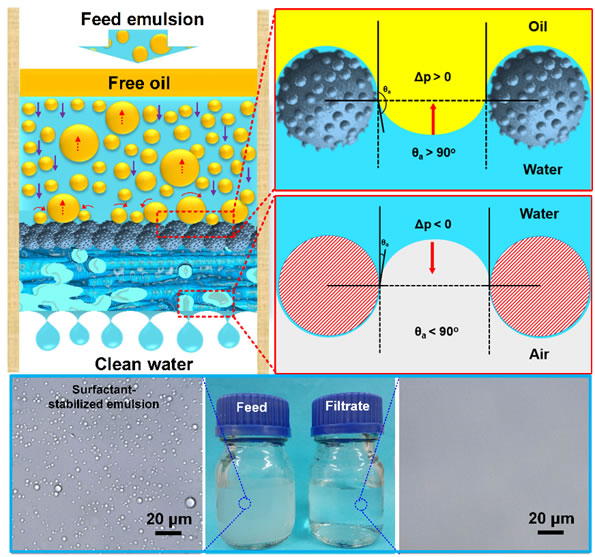Recently, the Ph.D candidate Jianlong Ge supervised by Prof. Yu and Prof. Ding in our college has made a breakthrough in the area of oil-in-water emulsion separation membranes. They successfully fabricated a novel superhydrophilic and underwater superoleophobic nanofibrous membrane with a hierarchical porous structures for the separation of oil-in-water emulsions viacombing electrospinning and electrospray methods, meanwhile, the separation mechanism of the emulsions was also investigated. This work was published with the tile of “Superhydrophilic and underwater superoleophobic nanofibrous membrane with hierarchical structured skin for effective oil-in-water emulsion separation” in a world authoritative academic journal in the field of nanomaterials and environmental sustainability research(J. Mater. Chem. A2017, 5, 497-502.)

Schematic illustrating the separation mechanism of oil-in-water emulsions and the separation performance.
Over the past few decades, the growing problem of water pollution resulting from ever-increasing industrial oily wastewater and frequent oil spill accidents has seriously threatened the safety of the ecological environment and human health. Thus, an effective treatment of oily water, especially the oil-in-water emulsion, is highly desired but still remains a worldwide challenge because of the complex phase state and quite small size of the oil droplets. The membrane separation method based on a polymerized been considered as an advanced technology for the separation of emulsions with acceptable efficiency, relatively low cost and an easy operational process. However, critical limitations still remain for the traditional separation membranes, such as low flux and easy fouling due to adsorption of the surfactant or pore plugging by oil droplets. Thus,the synchronously improvement ofthe separation flux and separation efficiency of the membranes is highly desired but remained a challenge.
To address this issue, researchersfacilely constructed a hierarchical structured skin layer on the surface of electrospun PAN nanofibrous membrane by using subsequently electrospray method. The hydrophilic SiO2 nanoparticles and PAN microspheres in the skin layer significantly enhanced the Cassie wetting effect of the membrane,which endowing the membrane superhydrophilicity (water contact angle 0°),meanwhile, the stable hydration shell formed on the surface of the membranes preventing its directional contact with the oil droplets,thus an underwater superoleophobicity(oil contact angle>160°)was obtained. Benefiting from the synergistic effect of the hierarchical porous structures and its highly selective wetting ability, the separation flux of the membrane for the model emulsion (n-hexane in water) was as high as 6290 L/m2h,and the oil content in the filtrate was <10 ppm. Additionally, there was no obvious decline of the permeation flux even after 10 separation cycles, indicating a robust recyclability.This work may provide a new routine for the design and fabrication of novel oil-in-water emulsion separation membranes.
This work is supported by the National Natural Science Foundation of China, the Fundamental Research Funds for the Central Universities, and the “DHU Distinguished Young Professor Program”.

